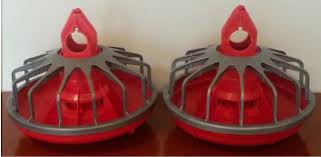1300 19th Street, N.W.
Suite 420 Washington, DC 20036
Cooped Up Case for Cooped Up Times
 Take a little tip from me. Stay away from my chicken house.
Take a little tip from me. Stay away from my chicken house.
/Stay Away From My Chicken House by Gene Autry

Entering our third week of staying at home, we look for connection from any quarter. Yesterday I found it in the form of a new trademark decision from the Fourth Circuit about chicken feeders. The Court of Appeals affirmed a lower court decision that nixed trademark protection for the shapes and color of the chicken feeder shown above on the left. The plaintiff had claimed that the configuration and red color scheme of its bird feeder had acquired trademark significance through years of commercial success. There was no doubt that the plaintiff’s feeder was popular among poultry raisers. And the defendant’s feeder (on the right) looked like a dead ringer for the plaintiff’s.
So why did the plaintiff’s trademark claim flounder and flail like a, well, the proverbial chicken with its head cut off? The problem for the plaintiff was it’s patents. Yes, product configurations and color schemes can theoretically attain trademark status through long use, large sales, and extensive advertising, especially if the advertising verbally or visually highlights the shape, features, or colors without touting their utility. But even if these measures have worked, even if consumers recognize a product’s shape, features, or colors as source indicators, i.e., trademarks, the law won’t extend trademark protection to features or shapes that are essential to the product’s function or purpose.
And here, the features and red color that the plaintiff claimed as trademarks were also covered by the plaintiff’s utility patents—strong evidence of their functionality. Indeed, the patents showed that the product shape allowed birds to feed more easily while the color red attracted them to their meals. As the court recognized, it is fundamentally unfair for a patent owner to convert the limited patent monopoly for useful features into a perpetual trademark monopoly, thereby depriving rivals of useful features needed to compete effectively.
The case is CTB Inc. v. Hog Slat Inc., case number 18-2107, in the U.S. Court of Appeals for the Fourth Circuit.
So, how does a case about chicken feeders provide meaning and connection in these days of isolation? Well, the first case I worked on as a fledgling trademark lawyer was about a chicken feeder. Early in the litigation, my fellow associate and I drafted up a scathing letter to the other side over some perceived deficiency. We loaded the correspondence with all the invective and indignation we could muster. The recipient happened to be the boyfriend of our mentor, and he worked for the rival firm across the street. He was an excellent lawyer and a wonderful guy, and he used his reply to school us neophytes about civility and effective advocacy, characterizing our screed for its “intemperate tone.” Of course, he cc’d our mentor, his girlfriend. From that day on my colleague and I became known throughout the firm as “The Intemperate Tones.” Good band name, bad nickname for young lawyers or lawyers of any age.
Moral of this post, don’t be so impressed with your own heated rhetoric that you lose sight of the ultimate goal, resolving disputes that counsel should be able to resolve cooperatively and failing that persuading not alienating the judge. Resist the urge to strut like a Rooster, lest you end up like the birds scrambling to feast at these feeders–served up on a plate for a judicial rebuke.
"I haven’t checked, but I highly suspect that chickens evolved from an egg-laying ancestor, which would mean that there were, in fact, eggs before there were chickens. Genius."
Ta-Nehisi Coates
Thank you!
Thank you for getting in touch!
We appreciate you contacting us. One of our colleagues will get back in touch with you soon!
Your cookies settings
XThis website stores cookies on your computer. These cookies are used to collect information about how you interact with our website and allow us to remember you. We use this information in order to improve and customize your browsing experience and for analytics and metrics about our visitors both on this website and other media. To find out more about the cookies we use, see our Privacy Policy.
More infoI Agree

